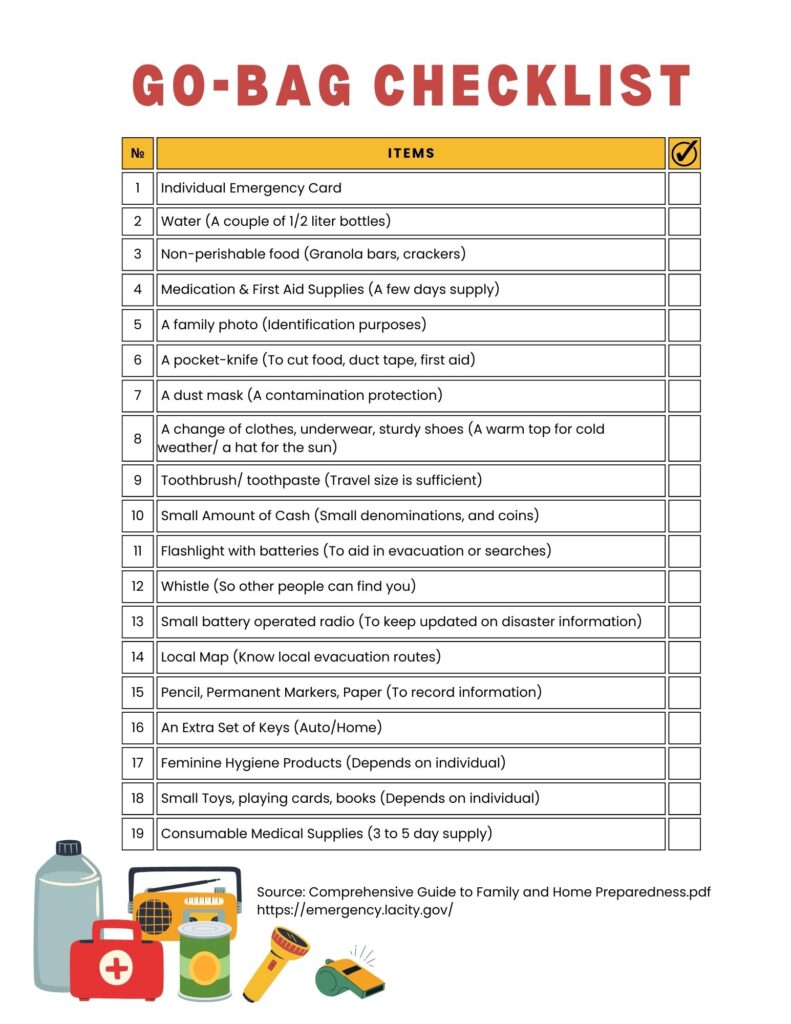Emergency Preparedness
Educating children about emergency preparedness is crucial for their safety in potentially dangerous situations. My daughter and I discussed various types of emergencies, such as natural disasters (earthquakes, floods, hurricanes), fires and medical emergencies. The Comprehensive Guide to Family and Home Preparedness provides a list of recommended topics parents can discuss with their children.

Family Emergency Plan
It is recommended that parents involve kids in creating a family emergency plan and discuss where to go and what to do during different emergencies. Make sure they know important contact numbers (911, parents’ cell phones, relatives).
Parents.com offers a helpful article called “How to Create a Family Emergency Plan.”
Family Emergency plan should cover at least four essential aspects:
- The location of emergency kits and go-bags
- A house map with two evacuation routes from each room.
- A contact list and Emergency cards for every family member.
- Establish a meeting place outside of your residence in case it becomes unsafe to stay indoors
Emergency Kit Checklist
Recently, we received a significant storm warning and some nearby stores ran out of flashlights, canned soup, and canned beans a day before the storm. This prompted me to consider what items we might need in case of a storm or power disruption.
The Center for Disease Control and Prevention (CDC) website provides an Emergency Kit Checklist for Kids and Families, available on its webpage titled “Caring for Children in a Disaster.”
Grab-and-Go Bag
In addition to the Emergency Kit, it’s advisable to assemble a Go-Bag —an individual emergency kit for each family member that can be easily carried in a backpack or similar bag. The distinction between an Emergency Kit and a Go-Bag is explained in this video.
What to pack in your grab-and-go bag:

Earthquakes
After a recent 5.5 magnitude earthquake, my daughter asked what to do during an earthquake. We discovered recommended information for kids on earthquake preparedness at www.ready.gov/kids. When indoors during an earthquake, remember to ‘drop, cover, and hold,’ as illustrated below, and we have practiced this technique:

When The Earth Shakes – Animated Video:
Fire Safety
Here are some fire safety tips from www.ready.gov:
- Make digital copies of valuable documents like birth certificates.
- Sleep with your bedroom door closed.
- Keep a fire extinguisher in your kitchen and seek assistance from your local fire department on its proper use and maintenance.
- Consider installing an automatic fire sprinkler system in your residence.
I taught my child the “Stop, Drop & Roll” technique through this video:
Other disasters and emergencies
For more information on various disasters and emergencies, visit www.ready.gov/be-informed. The Ready.gov website also offers a Kids Resource Library with a Youth Emergency Preparedness Curriculum tailored to different grade levels.
Food supply
In recent weeks, my daughter and I have been gradually accumulating non-perishable food items for our emergency food supply while grocery shopping. Maintaining a food (and water) supply is not only essential for emergencies but also helpful during food supply chain disruptions or shortages, such as the bird flu outbreak or the lack of essential items like bread or yeast in stores.
The Center for Disease Control and Prevention (CDC) recommends having at least a 3-day supply of food on hand, while the Federal Emergency Management Agency (FEMA) suggests maintaining a food supply sufficient for two weeks (see brochure called Food and Water in an Emergency.)
A 3-month or even a 1-year food supply is the ideal safety buffer in case of an emergency situation. This project will require some planning, budgeting, and tracking. Here is the link to the video with some helpful ideas how to prepare a 3-month supply of food.
Subscribe to our Newsletter
Thank you!
You have successfully joined our subscriber list.